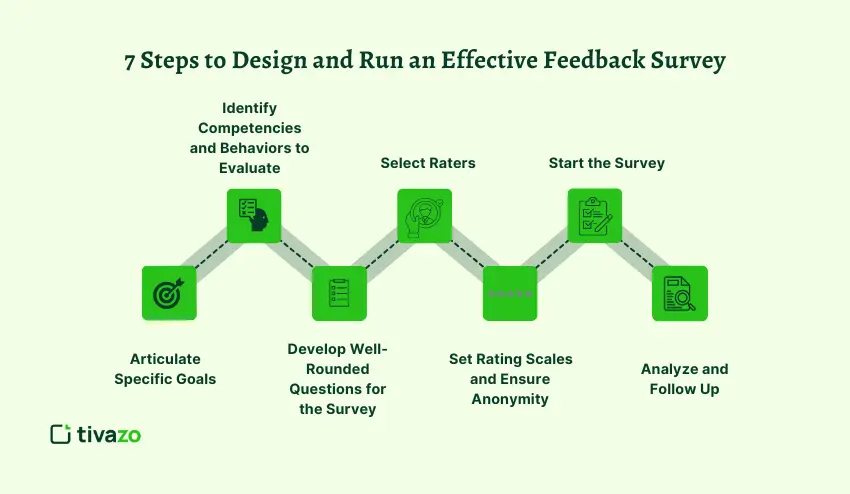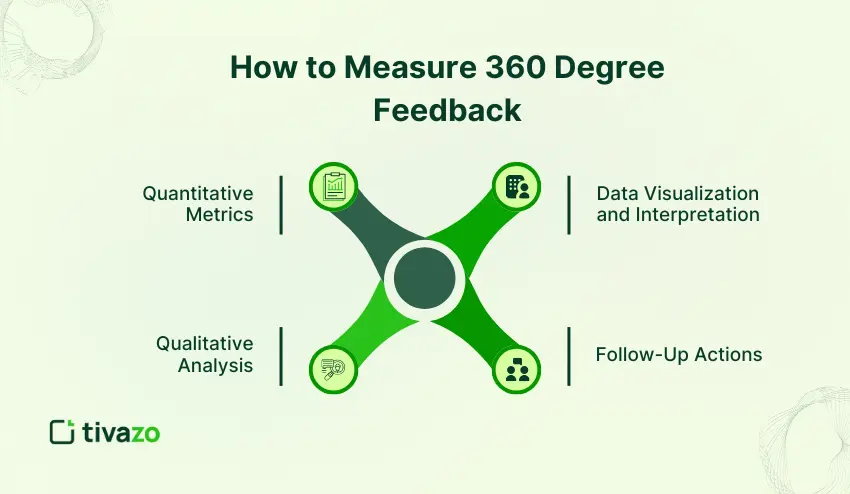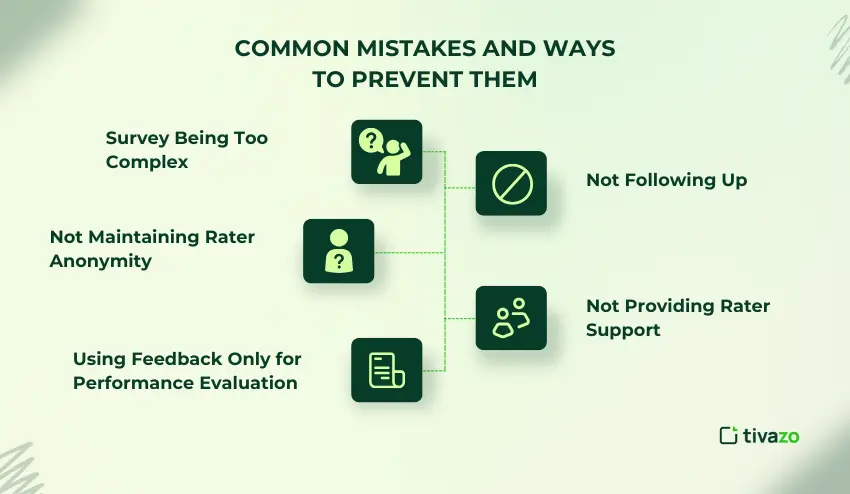Feedback has always been key for professional development. However, in many workplaces, it still feels like a one-way street, the manager’s view of the employee. A 360 degree feedback survey changes that perspective by collecting feedback from everyone who works with a person to include peers, direct reports, supervisors, and the employee themselves.
A typical review often focuses on performance ratings, whereas a 360 degree feedback survey reveals how people work together, lead, and contribute to the collective culture of the organization. It is a more expansive, just and practical style of developing individual and team performance.
In this guide, we will cover everything you will need to know about 360 degree feedback survey: what they are, why they matter, how to build one, how to measure the results of the feedback you have collected, and how to make feedback an integral part of your personal development plan. Whether you are a business owner, a manager, or an employee, you will learn how to use feedback, not as criticism, but as a map to continuous improvement.
What is a 360 Degree Feedback Survey?
A 360 degree feedback survey is a formal mechanism that gathers performance feedback about an employee, collecting feedback from individuals in multiple positions across the organization, managers, coworkers, subordinates, and even the employee themselves.
To put this simply, it is a “full circle” review that is used to help you gauge how well not only something is accomplished, but also the process of working with others to achieve it.
Prior to the use of 360 degree feedback surveys, most assessments were done by one individual, the first line supervisor. Whereas a 360 degree feedback survey systematically takes an inclusive perspective from assessments above, below, and around the employee being indicated. This represents a balancing point, increases transparency, and provides helpful insight into developmental needs of the employee to develop along the way to improve performance.
360 degree feedback surveys are common practice with leadership programs, performance appraisals, or employee development plans designed to focus on behaviors, communication, and teaming, rather than just outcomes of the job.
Here’s how it works in practice:
- The employee chooses a set of raters (coworkers, manager, direct reports).
- Each rater responds to a set of questions about the employee’s strengths and areas to improve.
- A report is generated and presented that highlights patterns, emergent gaps, and key pieces of evidence.
A 360 degree feedback survey offers a more nuanced, more comprehensive appreciation of how employees are recognized, and how well employees are working in the team, and can therefore inform organizational decisions about promotions, professional development and training, and leadership.
Why 360 Degree Feedback Surveys Matters
360 degree feedback survey tools are more than another HR form; they can elicit valuable information for all stakeholders involved.
For Owners:
- Get a complete understanding of company performance beyond numbers.
- Determine future leadership potential and team support needs.
- Build organizational culture by promoting communication and accountability.
For Managers:
- Learn how their leadership style impacts their team.
- Observe areas of team strengths and weaknesses.
- Use the feedback to help develop and coach employees more effectively.
For Employees:
- Receive an overall view of their work and behavior.
- Identify blind spots and other areas for improvement.
- Build stronger working relationships with peers and supervisors around constructive feedback.
Having feedback from multiple sources reduces bias when consolidating feedback into an overall experience report. 360 Degree feedback survey helps further build a transparent growth culture focused on continuous improvement so employees stay engaged while leaders can make decisions better informed through feedback.
Types and Variations of 360 Degree Feedback Surveys
Not every 360 degree feedback survey is the same. The type of survey you select should depend on your objectives, the size of your organization, and, importantly, the role you are evaluating. Below, we outline the primary variations:
1. 360 Surveys vs. 270 Surveys vs. 180 Surveys
- 360 survey: Feedback comes from all angles – manager, peers, subordinates (direct reports), and self.
- 270 survey: In 270 survey, feedback comes from everyone except the self-assessment. Commonly used in assessing role based on colleagues and direct reports.
- 180 survey: Feedback comes from managers (direct reports). This is a simple assessment and does not provide the depth of a 360 survey, but it may be convenient for busy managers.
2. Anonymous Surveys vs. Identified Surveys
- Anonymous: Respondents do not have their names attached to their responses, and offer the possibility of more honest value in the feedback.
- Identified: Respondents’ names are attached, which provides accountability but may reflect to lower levels of candor in feedback.
3. Role-Based Surveys
- Leadership Survey: Clearly focuses on/ reflects leadership roles; strategic thinking ability, decision making and work management ability in relation to people.
- Team or Technical Survey: Collaborating with the team to get a better idea on project execution and communication.
- Customer Facing Survey: Includes client feedback or vendor feedback to reflect performance.
4. Internal Surveys vs. External Surveys
- Internal: Respondents include managers peers, and subordinates within the organization
- External: Clients. vendors, or partners (e.g. a consultant) provide a valuable and unique perspective for an organization.
Ultimately, how you select from the options above will impact whether a survey provides you with meaningful information and insights; and not just data points. It’s essential to ensure whatever survey you administer, that survey is paired meaningfully to the outcome you want to replicate – be it employee development, leadership assessment, or team performance.
The Pros and Cons of Using 360 Degree Feedback Surveys
As with other methods of obtaining feedback, a 360 feedback survey has its upside and downside. Knowing and understanding the pros and cons of using this tool in their organizations will help companies make informed decisions about the purpose and implementation of a 360 degree feedback survey.
Pros
- Promotes self-awareness: Employees become aware of how others perceive their behavior.
- Encourages ongoing development and growth: Employees receive feedback on opportunities to improve and grow.
- Gathers multi-stakeholder perceptions and thinking: Feedback is necessary from those impacted from multiple perspectives: peer, manager, and subordinate.
- Builds communication and collaboration: Feedback creates openness, trust can be developed, and employees may feel more freedom to cooperate.
- Creates awareness of blind spots: Employees and managers are made aware of the behavior they were unaware of.
Cons
- Confusion or bias: The feedback horizons may be inconclusive or biased towards people’s opinions.
- Time consuming: Considerable time and resources are required to initiate, collect, and collate feedback.
- Facilitation: Results can be unwittingly misused if not properly facilitated with guidelines.
- Defensiveness: Employee reactions may create defensive postures if the feedback is not framed productively.
- Feedback overload: Employee reactions can include feeling overwhelmed with feedback if the heuristic is leveraged without prioritization.
If organizations create the right environment and mechanism to allow employees to receive feedback in a constructive way, most times the pros of employing a 360 degree feedback survey outweigh the cons. First and foremost, ensure clarity, confidentiality, and a Plan of Action.
7 Steps to Design and Run an Effective Feedback Survey
Developing a 360 degree feedback survey is more than simply asking questions; it is about creating and structuring a feedback process that will elicit thoughtful reflections. Here is how to accomplish this:

Step 1: Articulate Specific Goals
- Establish the purpose of the survey in the first place: development of leadership/capacity, improving team dynamics, or personal growth and development.
- The survey goals should also relate to company values and performance metrics.
- Articulating specific goals directs attention toward meaningful feedback, and future actions subsequent to those feedback.
Step 2: Identify Competencies and Behaviors to Evaluate
- Clearly define what skills, behaviors, or attributes that are most important for the role.
- Common categories may include: teamwork, accountability, collaboration, leadership, communications, problem-solving.
- Make sure to focus on observable and measurable behaviors and not characteristics or subjective attributes.
Step 3: Develop Well-Rounded Questions for the Survey
- Survey questions should focus on a compatible combination of rating scale questions (quantitative) and open-ended questions (qualitative).
- Ensure survey questions are clear, concise, and describe an unbiased perspective.
- For example, “How would you evaluate this employee’s effectiveness in collaboration with team members?” should be used in lieu of vague questions like, “Is this employee good at teamwork?”
Step 4: Select Raters
- Select a representative sample of managers, peers, and subordinate.
- You will want to select enough of a sample to feel comfortable about the reliability of the feedback – usually 5-12 for an employee.
- If applicable, consider including an external stakeholder to provide feedback (i.e. clients, vendors, etc.).
Step 5: Set Rating Scales and Ensure Anonymity
- Use standard scales (E.g., 1 – 5 or 1 – 7) for quantitative items.
- Determine whether feedback will be anonymous to allow honest responses.
- Provide clear and simple instructions for raters to follow in order to avoid any confusion.
Step 6: Start the Survey
- Use online surveys or software to easily organize collection and tracking.
- Clearly communicate purpose, deadlines, and confidentiality to participants.
- Send reminders out in order to support high levels of uptake.
Step 7: Analyze and Follow Up
- Summarize results using a report format that shows summary of area of strengths, gaps and trends.
- Analyze self-analysis compared to other raters to help determine areas of blind spots.
- Examine results constructively to allow for a growth plan.
- Schedule a follow-up to be certain there is action, and to use examples as to how it will be applied.
Example 360 Degree Feedback Survey Questions
Effective question creation is the essence of a strong 360 degree feedback survey. The appropriate balance of rating-scale and open-ended questions will collect measurable and descriptive feedback.
Example Rating-Scale Questions
(Scale: 1 = Strongly Disagree, 5 = Strongly Agree)
Leadership & Management
- Has a clear vision and direction.
- Provides appropriate, timely feedback to team members.
- Inspires and motivates others to perform at their best.
Communication & Collaboration
- Communicates clearly and effectively.
- Colleagues enjoy working with them across teams.
- Actively listens and takes perspective of others into account.
Problem-Solving & Decision-Making
- Approaches problems in a systematic way.
- Makes decisions with confidence and fairness.
- Demonstrate flexibility in a changing environment.
Accountability & Professionalism
- Demonstrates ownership of actions and outcomes.
- Consistently meets deadlines.
- Exhibits a high standard of professionalism.
Sample Open-Ended Questions
- What do you consider to be the primary strengths of the employee?
- What do you consider to be areas for improvement for the employee
- What is a specific experience when the employee was effective?
- What are some positive ways the employee contributes to the success of the team?
- Do you have any other thoughts or recommendations?
Guidelines to use in writing survey questions
- Use neutral language ( be intentional in your work against bias).
- Focus on actions or behavior instead of intrinsic characteristics or personality traits (yes, this is something that is easily overlooked).
- Keep the number of items to a minimum of between 15-20 total items to reduce fatigue.
- Use a combination of quantitative and qualitative items to provide a more robust understanding.
A carefully developed question set will yield meaningful and trusted survey results and will clarify performance and areas of growth for employees.
How to Measure 360 Degree Feedback
The measurement of a 360 degree feedback survey involves more than just gathering responses. To drive individual and organizational developmental growth, the idea is to leverage feedback as actionable insight.

1. Quantitative Metrics
To begin with, look at the numerical ratings. For example, calculate an average score for each competency, such as leadership, communication, teamwork, and accountability. Using that average score as a starting point, look at how the scores from self-ratings stacked up with the feedback received from peers, managers, and subordinates.
Using the ratings as a means of shining a light on areas of responsible weaknesses or blind spots (i.e., where employees think they were above average with respect to competency, but those who provided feedback thought they were below average). Then, you might want to look at the distribution and range of ratings as they may further highlight patterns, problems, or bias that can be taken into account when interpreting the results.
2. Qualitative Analysis
The open-ended questions provide context behind the numerical ratings. It would be helpful to identify themes for strengths, weaknesses, or opportunities for merging into ways to improve. When identifying themes, pay attention to comments specifying specific behaviors or skills versus universal opinion. Merging qualitative themes with the quantitative rating will provide a deeper understanding of the overall feedback process, and help explain any numbers that may not seem consistent.
3. Data Visualization and Interpretation
Visual representations make the data an easier to read and communicate to other people. For example, radar charts are helpful in representing multiple competencies simultaneously. Heatmaps can help identify strengths and weaknesses across teams. Creating graphs and tables may assist with comparing scores across raters, departments, or time, and quickly spotting trends among possible areas of focus to address actions. Visual representations are especially useful for communicating back to employees results in a way that is easy to understand and take action.
4. Follow-Up Actions
Ultimately, the purpose of measurement is to improve. Leverage the data from the survey to develop individual development plans, establish measurable objectives, and track these objectives over time. Conduct follow-up surveys or check-in meetings to assess change and improvement. You can also aggregate the data together and use that aggregated data to inform your organizations initiatives, including training programs, leadership development, and team building experiences. Follow-up action ensures that your 360 degree feedback survey leads to improvement rather than simply assessing and collecting data.
Common Mistakes and Ways to Prevent Them
Mistakes can happen anytime. Even carefully designed 360 degree feedback surveys may not be effective without avoiding some common traps.

1. Survey Being Too Complex
Having a survey that is too long or complicated may result in uninformed or untimely responses. Ask clear, sane, focused questions that go specifically to the competencies or other behaviors that you’re assessing.
2. Not Maintaining Rater Anonymity
If your participants think their names will be shared, they may not give honest feedback. It is of crucial importance that staff members guidelines and agree to the confidentiality of their responses – and that you communicate this simply and concisely.
3. Using Feedback Only for Performance Evaluation
If your staff treats the survey as the “judgment of their performance” rather than a developmental tool, they may end up defensive. Clarify that growth and reflection is the goal of administering the survey.
4. Not Following Up
If you collect feedback and do not engage after that, you risk losing trust. You can even analyze the results as simply as tallying the positive vs. negative comments made, share insights related to feedback in a thoughtful way, and then discuss what can be done for development.
5. Not Providing Rater Support
If you do not advise participants how to rate effectively, feedback may end up being too vague or inconsistent across the board. Providing suggestions and examples is an effective way for participants to provide feedback that is useful and objective.
Conclusion
An appropriately constructed 360 degree feedback survey is more than a performance evaluation tool, it’s also an incredible opportunity for development, trust, and team communication. Although typically done in a meeting format or online, the feedback is from managers, peers, subordinates, and the employee themselves to create a holistic view of performance, behaviors, and development opportunities.
The success of a 360 degree feedback survey depends on strategic process considerations, clear objectives, careful measurements, and completion of action later. When done properly, 360 degree feedback can help employees identify performance strengths, recognize areas of improvement, and take purposeful steps toward professional growth. For managers and owners, it’s valuable information for their leadership development, training, and promotions.
If your organization is looking to improve performance and establish a culture of continuous improvement, then a 360-degree feedback survey can be the first step towards real change. Keep it simple, be open and transparent about the process, and use the information to facilitate real development, you can let the results speak for themselves.




